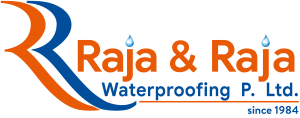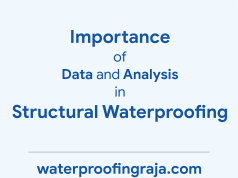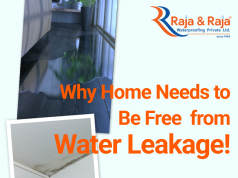What do you mean by Above Grade Structure (Open to Sky Structure):
Above grade structures are also known as Building structure. These structures are fully above the ground level and exposed to atmospheric conditions.
Above grade structures generally undergoes the following:
- Air Pressure differences
- Hot & Cold Cycles due to climatic conditions
- Wind forces
- Surface tensions
- Exposure to UV rays
- Carbonation
The structural movements occurring within the core of the earth leads to currents & movements at the ground, which also moves within structures. This movement leads to the development of cracks due to surface tensions
The prevention of water intrusion into the exposed structure through the combination of materials or systems.
This type of Waterproofing is can be subjected to hydro-static pressure created because of wind conditions and are exposed to weathering and carbonation.
Above Grade Waterproofing
Water is present in various forms like Ice (Solid), Water (Liquid) & Vapor (Gas) forms. Above grade structures usually faces vapour and liquid state and creates damages in many unique ways.
Water causes damages by vapour transmission through porous surfaces, by direct leakage in a liquid state.
Above-grade waterproofing systems are barrier systems (Barring Water & Vapor both; These systems don’t allow any kind of water transmission but allow negative vapour transmission.) This process is identical to Human skin. Human skin allows you to Bathe and swim but at the same time, it allows you to perspire (Sweat) which is called negative vapour transmission.
Challenges Above grade waterproofing undergoes Or What are the causes of Water intrusion in Above grade structures?
The main causes of Intrusion in above-grade structures are
- Natural Gravitational forces: The water entering due to gravitational forces is high in volume on the horizontal and slightly inclined portion of the structure
- Surface tensions: The surface tension created due to molecules of water allows it to stick and travel along the undersides of the structural envelope such as joints. Also, the same water can be drawn into the structure by gravity or air pressure differences
- Environmental Air Pressure differences: Environmental Air pressure has its principle; it migrates from the high-pressure zone to the low-pressure zone.
If the air pressure inside the structure is less than the air pressure in the surrounding, water would be sucked into the structure - Wind forces: Wind loads during heavy rains & rainstorms can force water into interior areas if the structural envelope is not wind resistant structurally.
Example: Curtain Walls (Sidewalls) and glass can bend and flex away from gaskets and sealant joints resulting in the direct access to the water. - Capillary actions: Capillary action means natural upward motion that draws water from lower ground sources to the higher ground periphery. Same way walls resting on exposed horizontal portions of structure (Example Balcony Decks (can be affected by the capillary action of any ponding or standing water on these areas.
- Hot & Cold Cycles due to climatic conditions: The temperature transition with two parts of day and night makes the external structure undergoes expansion & contraction. Due to this repeated cycle, the surface envelope tends to crack/fracture at some interval of time and these cracks are a doorway to water ingress.
- Degradation due to Exposure in UV rays: UVA rays are called ‘Ultra-violet A’ rays. These rays are electromagnetic radiation with 10nm to 400nm wavelength. These rays impact the exterior concrete or polymer paint and degrade the same resulting in the breach of the external envelope.
- Carbonations: Carbonation is referred to as reaction of the surface with carbon dioxide available in the environment to form free carbonates, bi-carbonates. These reactions damage the structural envelope eventually creating a void for water intrusion.
What are the types of Above-Grade Waterproofing?
Waterproofing for the above ground at the exterior of structures is also called as Surface Waterproofing; which in by default should be barrier system if done along with structure erection otherwise prevention-based system by default as waterproofing for post erection of structure; and is carried out at the exposed component of the structure or structural envelope.
These system/materials are not subjected to any ground hydro-static pressures but they have a complete exposed condition to hydro-static pressure created because of wind & other climatic conditions and are exposed to weathering, UV rays and carbonation.
Also read: Step by Step Waterproofing of existing Terrace with Chemical treatment



